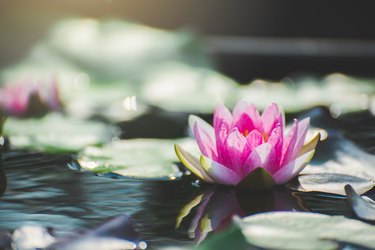
The magical lotus flower (Nelumbo nucifera, USDA plant hardiness zones 5 to 10) is the symbol for purity, grace, beauty, knowledge and many other good things. It represents different things to different societies, and learning about the parts of a lotus flower is key to understanding how it lives and thrives. This rhizomatous aquatic perennial has horizontal stems that grow underneath in the water, and it returns to bloom year after year.
Parts of a Lotus Flower
Video of the Day
It can be helpful to look at a diagram of a lotus flower plant that shows what it looks like. The rhizome roots are at the bottom and center of lotus flowers, and the stems and leaves grow from the bottom of the plant.
Video of the Day
There are even more lotus parts names. A lotus plant has a large green seedpod that contains seeds and a receptacle. The large flower of a lotus plant also grows from the rhizome and has a stamen in the middle.
During the summer, stems grow from the underwater rhizome roots and produce swollen flower buds. The stem attached to the flower bud base is called a peduncle, and the bud is covered in pale green leaves known as sepals. These open up slowly as the flower's petals come out.
Post-Pollination Lotus Flower Processes
After pollination takes place, the lotus flower starts breaking down. Its petals, stamens and other parts simply drop down into the water and gently float away. Then, the carpellary receptacle swells up as its fertilized ovule turns into a new seed.
From there, the receptacle becomes larger, ripens and turns brown. It produces embryos that turn into dry brown seeds, and the peduncle slowly dries up and tilts the receptacle, which is basically a seed capsule. Ripe seeds roll from here into the water. Then, new lotus flowers can grow.
More About Lotus Plants
There are approximately 100 species of lotus, and the sacred lotus (Nelumbo nucifera Gaertn, USDA plant hardiness zones 4 to 10) is the national flower of India. Another variety is the lovely Egyptian blue water lily (Nymphaea caerulea, USDA plant hardiness zones 10 to 12). This variety has vibrant blue flowers that bloom from July until September.
You can purchase lotus plants from garden supply companies, and they are typically shipped as tubers. To plant one in a pot, look for a container that is nice and deep. Add a few inches of sand and top that off with a few inches of topsoil. Be sure that you do not add potting soil. Make an indentation in the soil and lay in the tuber with the roots down and tips up. Cover this with more soil but do not push down the dirt.
Add enough water to create wet mud without any standing water. The tuber needs to stay warm, so put it on a heating pad set on low if the house is cold. Once the leaves appear, give the lotus at least eight hours of sun per day. Water as needed; the lotus does not need to live in a body of water to survive.